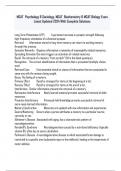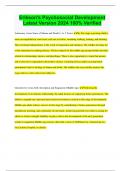MCAT Psychology & Sociology , MCAT Biochemistry & MCAT Biology Exam Latest Updated 2024 With Complete Solutions Long -Term Potentiation (LTP) A persistent increase in synaptic strength following high-frequency stimulation of a chemical synapse. Retrieval Information sto red in long -term memory can return to working memory through this process. Semantic Networks Organize information in networks of meaningfully related memories. Spreading Activation One item triggers an activation of related memories. Recall The retrieval o f a memory "from scratch" (fill in the blank questions). Recognition The correct identification of information that is presented (multiple -choice test). Retrieval Cues Environmental stimuli or pieces of information that are associated in some way with the memory being sought. Decay The fading of a memory. Primacy Effect Recall is strongest for items at the beginning of a list. Recency Effect Recall is strongest for items at the end of a list. Interference Similar information prevents the retrieval of a memo ry. Retroactive Interference Newly learned material prevents successful retrieval of older memories. Proactive Interference Previously held knowledge prevents successful retrieval of more newly learned information. Memory Construction Memories are updated with new information and experiences. Source Monitoring Occurs when a person attributes a memory to a particular source, correctly or not. Alzheimer's Disease Associated with aging, has a characteristic pattern of neurodegeneration. Korsakoff's Syndrome Neurodegeneration caused by a nutritional deficiency (typically vitamin B1), often due to severe alcoholism. Parkinson's Disease A neurodegenerative disease in which associated brain damage is restricted to a specific area (substantia nigra in the midbrain), leading to the impairment of motor abilities. Biopsychosocial Approach Illuminates the importance of psychological and sociological study in medicine. Biomedical Approach Focuses narrowly on the physical aspects of illness. Social Constructionism Human a ctors construct or create "reality" rather than discovering a reality that has inherent validity. Symbolic Interactionism Explains social behavior in terms of how people interact with each other via symbols. Symbols Terms, concepts, or items that represent specific meanings by accepted convention. Functionalism Factions of society work together to maintain stability. Claims that society, like an organism, is a system that consists of different components working together. Conflict Theory Views society in te rms of competing groups that act according to their own self -interests, rather than according to the need for societal equilibrium. Culture All the beliefs, assumptions, objects, behaviors, and processes that make up a shared way of life. Material Culture The objects involved in a certain way of life (products manufactured, tools used, art made, etc.). Non-material culture Encompasses the elements of culture that are not physical (ideas, knowledge, etc.). Social Norms Expectations that govern what behavior is acceptable within a group. Social Group A subset of a population that maintains social interactions. Symbolic Culture A type of non -material culture that consists of the elements of culture that have meaning only in the mind. Rituals Formal, ceremonial behaviors with a specific purpose and significance. Society Two or more individuals living together in a community and/or sharing elements of culture. Social Institutions Hierarchical systems that bring order to interpersonal interactions, structuring soci ety. Government and Economy A type of social institution. _____ provides order to society through the services it provides and making/enforcing law. The _____ distributes goods and services to meet the needs of society. Education A type of social instituti on. Provides a formal structure during childhood/transition into adulthood and an opportunity to instruct youth on the social norms, knowledge, skills, expectations needed. Religion A type of social institution. A system of beliefs that affects how people make sense of their experiences and provides a framework for questions about life, death, existence. Family A type of social institution. Consist of bonds of kin and marriage and make up a major organizing institution of society. Health and Medicine A type of social institution. Fulfills the need for healthcare in an organized manner. Demographics Statistics used to examine the nature of a specific population. Demographic Parameters (examples) Age, gender, race, ethnicity, sexual orientation, immigration st atus. Demographic Transition A demographic change that takes place over time. Fertility The production of offspring within a population. Mortality The death rate within a population. Migration The relocation of people from one place to another. Social Move ment A group of people who share an ideology and work together toward a specified set of goals. Urbanization The increase in the proportion of people living in specified urban areas. Globalization The increasing amount of interaction and integration on the international scale through exchange of products, services, ideas, and information. Spatial Inequity The unequal access to resources and variable quality of life within a population/geographical distribution. Global Inequalities Disparities between region s and nations in aspects such as GNP, natural resources, access to healthcare, types of work available. Environmental Justice The equal treatment of all people regardless of social grouping with regard to prevention and relief from environmental and health hazards. Social Class A system of stratification that groups members of society according to similarities in social standing. Tied to status and power in the community. Privilige Having advantages of power and opportunity over others. Prestige The relativ e value assigned to something within a particular society. Upward Mobility Moving up the class system. Downward Mobility Moving lower withing the class system. Intragenerational Mobility A change in social position that occurs in a person's lifetime. "Rags to riches". Intergenerational Mobility Changes in social status between different generations within the same family. Meritocracy A society in which advancement is based solely on the abilities and achievements of the individual. Cultural Capital The set of non -monetary social factors that contribute to social mobility. Social Capital An individual's social networks and connections that may confer economic and/or personal benefits. Poverty An insufficiency of material goods, monetary wealth, access to reso urces. Isolation/Social Exclusion Social disadvantage and relegation to the fringe of society. Absolute Poverty A lack of essential resources (food, shelter, clothing, hygiene). Relative Poverty Social inequality in which people are relatively poor compare d to other members of the society in which they live. Health Disparity/Inequity Differences in health and healthcare that occur between groups of people. Learning Associative Learning/Conditioning Involves associations between certain stimuli and specific responses. Classical Conditioning A test subject develops a response to a previously neutral stimulus by associating the stimulus with another stimulus that already elicited that response (Pavlov). Unconditioned Stimulus A stimulus that elicits an uncondi tioned response (food [US] --> salivation [UR]). Unconditioned Response A behavior that occurs naturally due to a given stimulus (food [US] --> salivation [UR]). Neutral Stimulus A stimulus eliciting no response. Conditioned Stimulus A previously neutral s timulus that, after repeated association with an unconditioned stimulus, elicits the response produced by the unconditioned stimulus itself (bell [CS] --> salivation [CR]). Conditioned Response An automatic response established by training to an ordinarily neutral stimulus (bell [CS] --> salivation [CR]).





